
Features
Forestry Management
Harvesting
Canada’s changing certification landscape
A look at the changing forest management paradigms and certification numbers
August 10, 2020 By Tony Rotherham
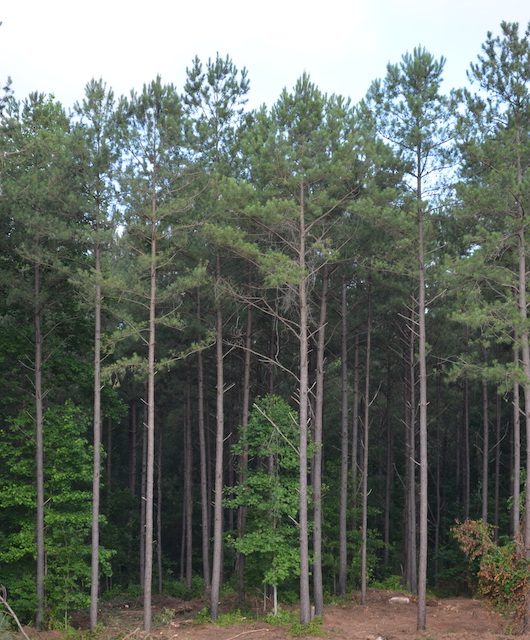 Photo: Annex Business Media
Photo: Annex Business Media When it comes to forest certification, Canada is a global leader, with approximately 168 million hectares (ha) certified. There are three certification programs for sustainable forest management (SFM) used in Canada: the Canadian Standards Association (CSA) and the Sustainable Forestry Initiative (SFI), along with several standards endorsed by the Forest Stewardship Council (FSC).
Forest management evolution
We have been actively harvesting timber from Canada’s forests since the 1600s. During the past 400 years, the commonly accepted approach to the “management” of our forests has changed significantly. The chart below provides an idea of the evolution of “forest management paradigms over a 400-year period in our history.
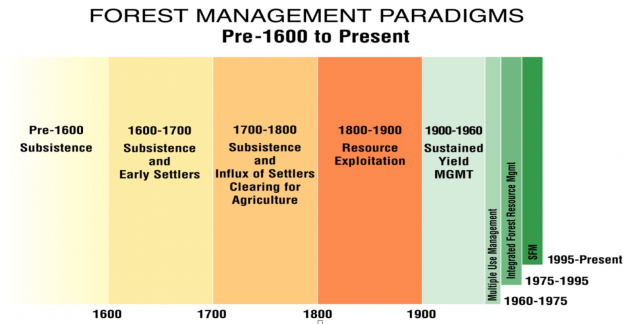
Credit: Armson & Rotherham
Subsistence
Prior to 1600, the management paradigm was essentially subsistence use of the forests by First Nations peoples. In some parts of southern Ontario and Quebec, this included significant clearing for crop production. The 200-year period from 1600 to 1800 brought an influx of European settlers whose main activities were the clearing of the forest for agriculture and the establishment of small water-powered mills for local lumber production.
Forest resource exploitation
In 1807, Napoleon blocked Britain’s access to Baltic timber. This started the exploitation of pine and oak forests in Eastern Canada. During this period, the forest was ‘mined’ for timber with little or no thought to regeneration. Fortunately, this happened on a relatively small scale. The annual timber harvest in the late 1800s was about 20 million m3.
Sustained Yield Management
The late 1800s to early 1900s saw the rise of the pulp and paper industry in Canada. Expensive mills required a large, secure timber supply provided by the allocation of large areas of publicly-owned forest under Sustained Yield Management. This required forest inventories, growth calculations, the establishment of allowable annual harvest levels and long-term planning. The focus was on wood supply.
Multiple-Use Management
From 1960 -1975, the concept of Multiple-Use Management was implemented. As Canada recovered from the Second World War and leisure time increased, so did public pressure to use the forests for recreation, hunting and fishing. The networks of forest roads made the forests more accessible. But public users’ needs had to be considered and changes were made to management planning and operations to accommodate their use of the forest.
Integrated Forest Resource Management
During the early 1970s there arose the need to integrate other values into the forest management planning process. These included non-timber elements such as wildlife habitat, riparian reserves to conserve water quality, fisheries, recreational use, ecological values such as “old growth” and impacts on the forest landscape. This new paradigm was called Integrated Forest Resource Management.
Sustainable Forest Management
The present forest management paradigm is Sustainable Forest Management (SFM). The SFM paradigm was developed after the failure to agree on an International Convention on management of the world’s forests at the 1992 Earth Summit in Rio. SFM was defined through the work of eight regional Inter-Governmental Processes for SFM Criteria and Indicators (C&I) sponsored by the United Nations. Canada is one of 12 participants in the Montreal Process (C&I for non-European Temperate and Boreal Forests). The Montreal Process C&I were refined for application in Canada by an expert committee working under the Canadian Council of Forest Ministers and became the framework for SFM Standards in Canada.
The evolution of paradigms has accelerated since 1900. This is due to an increase in the rate of harvest to meet the needs of a growing world population, improvements in our knowledge of forest science and changes in public values. Canadian harvest levels in 1920 were about 50 million m3. In 2017, we harvested about 160 million m3, down from a high of 209 million m3 in 2004. Our national annual allowable cut (AAC) is reckoned to be about 220 million m3/yr.
A changing landscape
Internationally, there are two SFM certification programs: The Program for the Endorsement of Forest Certification (PEFC) and the Forest Stewardship Council.
The international statistics at the end of 2019 are shown in the table below:
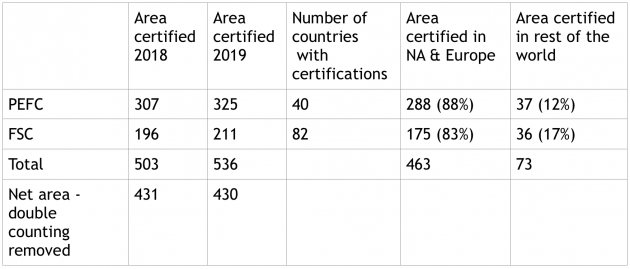
Table 1: Certified Forest Area (millions of ha). Data from the PEFC and FSC websites
But the certification landscape in Canada has changed dramatically in the past year. The big change is the 20-million-hectare reduction in area certified to the CSA SFM program. Forest managers have instead chosen to have these 20 million hectares of forest certified to the SFI Program, which increased by 25.7 million hectares in 2019 alone. In contrast, the area certified by the FSC has dropped by 2.2 million hectares.
Many will wonder why companies decided to drop the CSA Program and adopt SFI in 2019. There are several contributing factors.
The SFI program includes many activities and alliances that increase market and public recognition of SFI. These include: Project Learning Tree, co-operation with Ducks Unlimited, and programs to promote work experience in forest management for youth, including First Nations, as well as-SFI’s Small Scale Module for Indigenous Peoples, Families, and Communities, designed for certification of First Nations’ forest lands, smaller forest properties and community forests. The purchase of sawmills in the U.S. that are part of the SFI system may also be a factor.
The graph below shows the area of forest land certified to each of the three SFM forest certification programs recognized in Canada. Some management units have been certified to two programs. See Tables 2 and 3 for actual areas and the net area certified with double certifications removed.
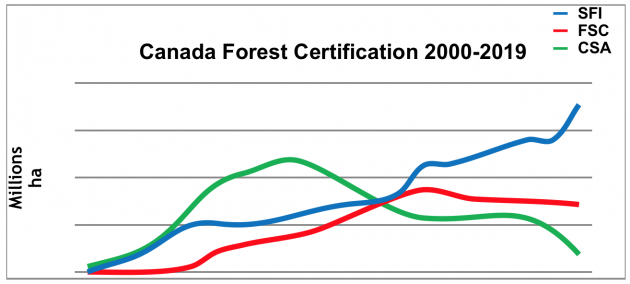
Table 2: Forest Land Area of Canada
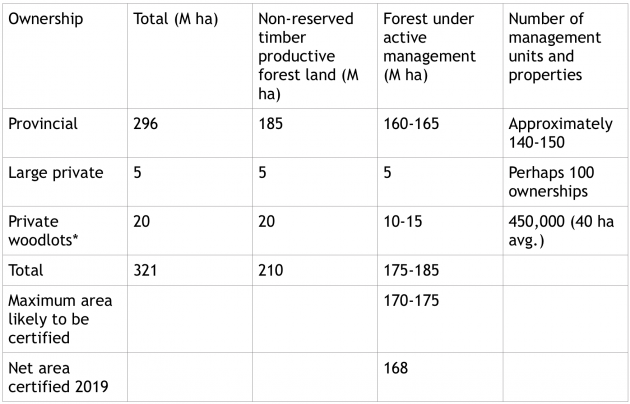
*Many woodlots are not actively managed and certification is expensive.
Table 3: Area of Certified Forest Land in Canada – (millions of ha)
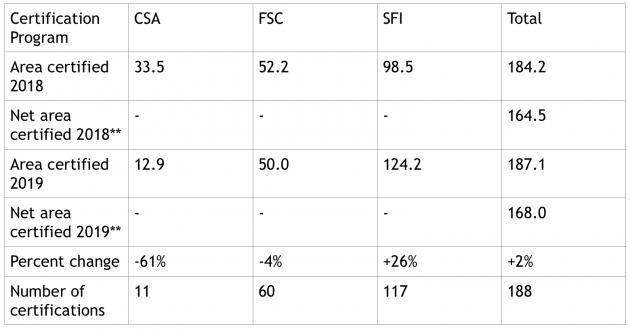
** Double counting removed
Table 3 has information from the 2019 year-end status report on Certification in Canada published by FPAC in February. Note that some management units have been certified to two certification programs. The figures for net area certified shows the total area of forest certified with the double counting removed.
Across Canada, there are about 450,000 private woodlots. On average, they are 40 hectares in size. These woodlots are owned and managed for a variety of reasons: timber production, family tradition, conservation and wildlife habitat, hunting and fishing. Private woodlots produce about 14 per cent of the Canadian wood supply but it comes from many different small operations each year.
It is a huge task to prepare management plans for so many small properties. These factors make the certification of all 20 million hectares of woodlots an expensive and complex proposition. It is likely that only a small proportion of woodlots will be certified.
The good news is that we continue to increase the total area of certified forest in Canada – up from 164.5 million hectares in 2018 to 168 million hectares at the end of 2019. This is not a huge increase, but it all helps. We are getting close to 170-175 million hectares, the maximum area likely to be certified in Canada.
It takes time and effort to implement a new management paradigm for the management of 180 million hectares of forest land divided among many owners/managers. The implementation of SFM on 168 million hectares of forest management units across Canada has been greatly accelerated by certification.
Tony Rotherham (RPF B.C. and Ont. (ret’d)) has worked on woodlands operations in B.C., Ontario, Quebec, Kenya and Iran. He worked for the CPPA (now FPAC) in the Woodlands Section for 21 years and since then as a consultant, largely on private forest land policy.
Print this page